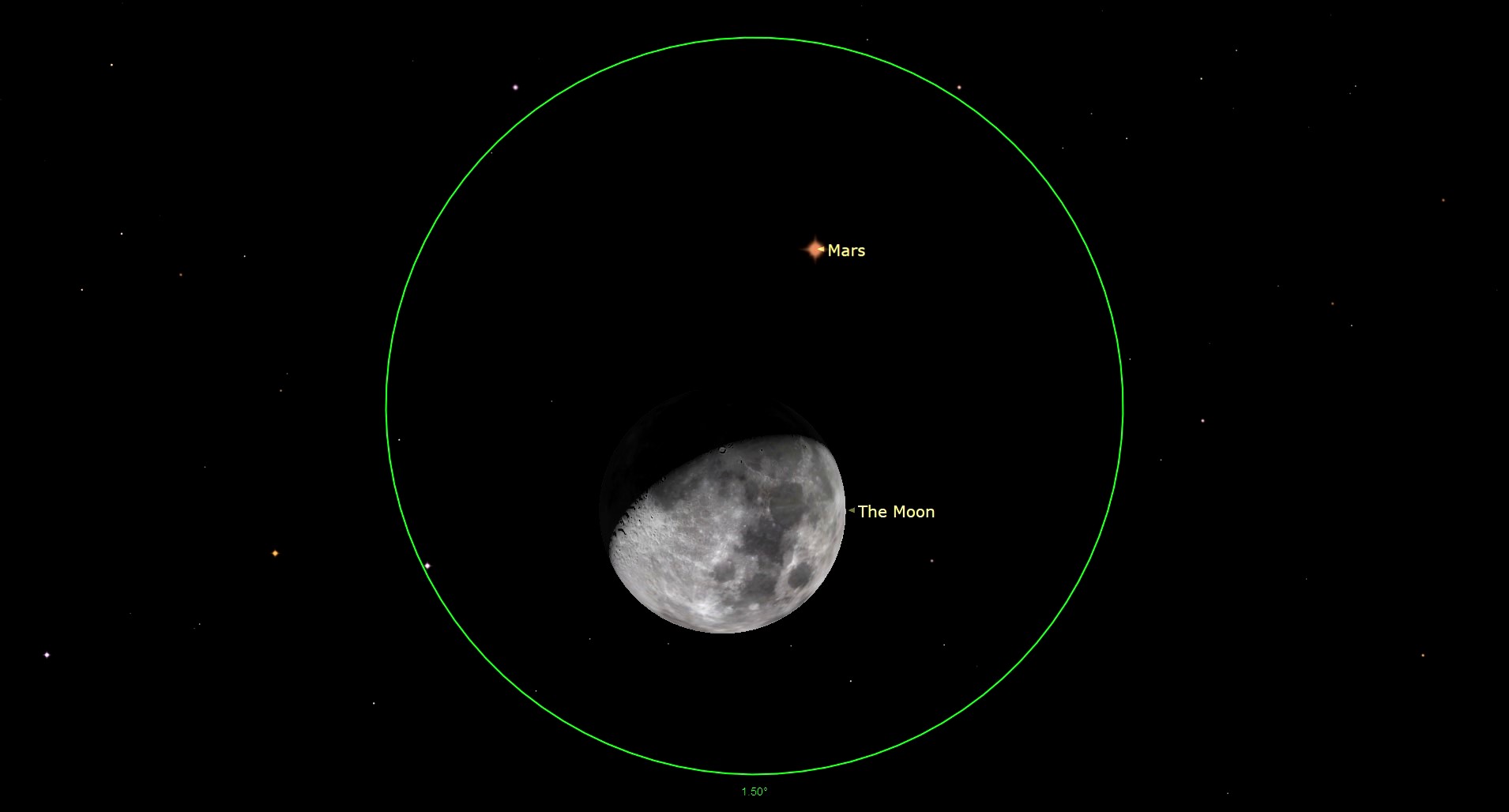See the moon eclipse Mars on Jan. 30 in free telescope webcast
During the Griffith Observatory's livestream of the lunar occultation of Mars, the Red Planet will disappear behind the moon.

The moon will eclipse Mars next week, and you can watch the event live from the comfort (and warmth!) of your own home.
On Monday (Jan. 30), Mars will disappear from view behind the moon during an event known as a lunar occultation. Skywatchers in the southernmost United States, stretching from California to Florida, as well as Mexico, Central America and the Caribbean should be able to see the spectacle in the night sky starting around 8:30 p.m. PST for Los Angeles. A list of optimal viewing times can be found on Space.com courtesy of veteran skywatcher Joe Rao.
For interested skywatchers who live outside of the viewing area or aren't keen on braving a cold January night, the Griffith Observatory in Los Angeles is hosting a free online livestream of the event courtesy of the observatory's website or its YouTube channel. The livestream begins on Monday (Jan. 30) at 11:00 p.m. EST (0400 GMT on Jan. 31) and will last for two hours.
Related: Don't miss the moon eclipse Mars next week on Monday (Jan. 30)

Want to get a good luck at the lunar occultation of Mars? We recommend the Celestron Astro Fi 102 as the top pick in our best beginner's telescope guide.
During the Griffith Observatory's livestream of the lunar occultation of Mars, the Red Planet will disappear behind the moon around 11:36 p.m. EST (0436 GMT on Jan. 31) and then reappear nearly an hour later at 12:30 a.m. EST (0530 GMT).
The last lunar occultation of Mars occurred on Dec. 7, 2022 under December's full Cold Moon and wowed skywatchers, many of whom managed to take plenty of stunning photos. The Griffith Observatory also released gorgeous footage of that previous occultation, giving some sense of what to expect for this next one on Monday.
For Monday's lunar occultation of Mars, the moon will be a 68% illuminated waxing gibbous, according to Farmer's Almanac. Mars, meanwhile, will also not be as bright as in December's lunar occultation. The Red Planet has moved close to 30 million miles (48 million kilometers) farther away from Earth since that event, appearing far less bright than the last time it was eclipsed by the moon.
Breaking space news, the latest updates on rocket launches, skywatching events and more!
Nevertheless, this should prove to be a photogenic lunar occultation of Mars due to the fact that the Red Planet will approach the moon from the west and disappear behind its darkened limb, while reappearance will then take place on the bright side of the moon's disk.
If you live outside of the viewing area for the lunar occultation and prefer to skywatch in person, you will still be treated to a celestial show as the moon and Mars appear close together in the night sky during an event known as an appulse. You can find a table of viewing times and locations in our occultation story from earlier this week.
If you want to get a front-row look at the lunar occultation of Mars or the close approach of the Red Planet and the moon, our guides for the best telescopes and best binoculars are a great place to find the gear you need. If you're looking to take some photos of the event, see our best cameras for astrophotography and best lenses for astrophotography.
Editor's Note: If you get a great photo of the lunar occultation of Mars or the close approach of the Red Planet and the moon and would like to share it with Space.com's readers, send your photo(s), comments, and your name and location to spacephotos@space.com.
Follow Brett on Twitter at @bretttingley. Follow us @Spacedotcom, or on Facebook and Instagram.

Brett is curious about emerging aerospace technologies, alternative launch concepts, military space developments and uncrewed aircraft systems. Brett's work has appeared on Scientific American, The War Zone, Popular Science, the History Channel, Science Discovery and more. Brett has degrees from Clemson University and the University of North Carolina at Charlotte. In his free time, Brett enjoys skywatching throughout the dark skies of the Appalachian mountains.
